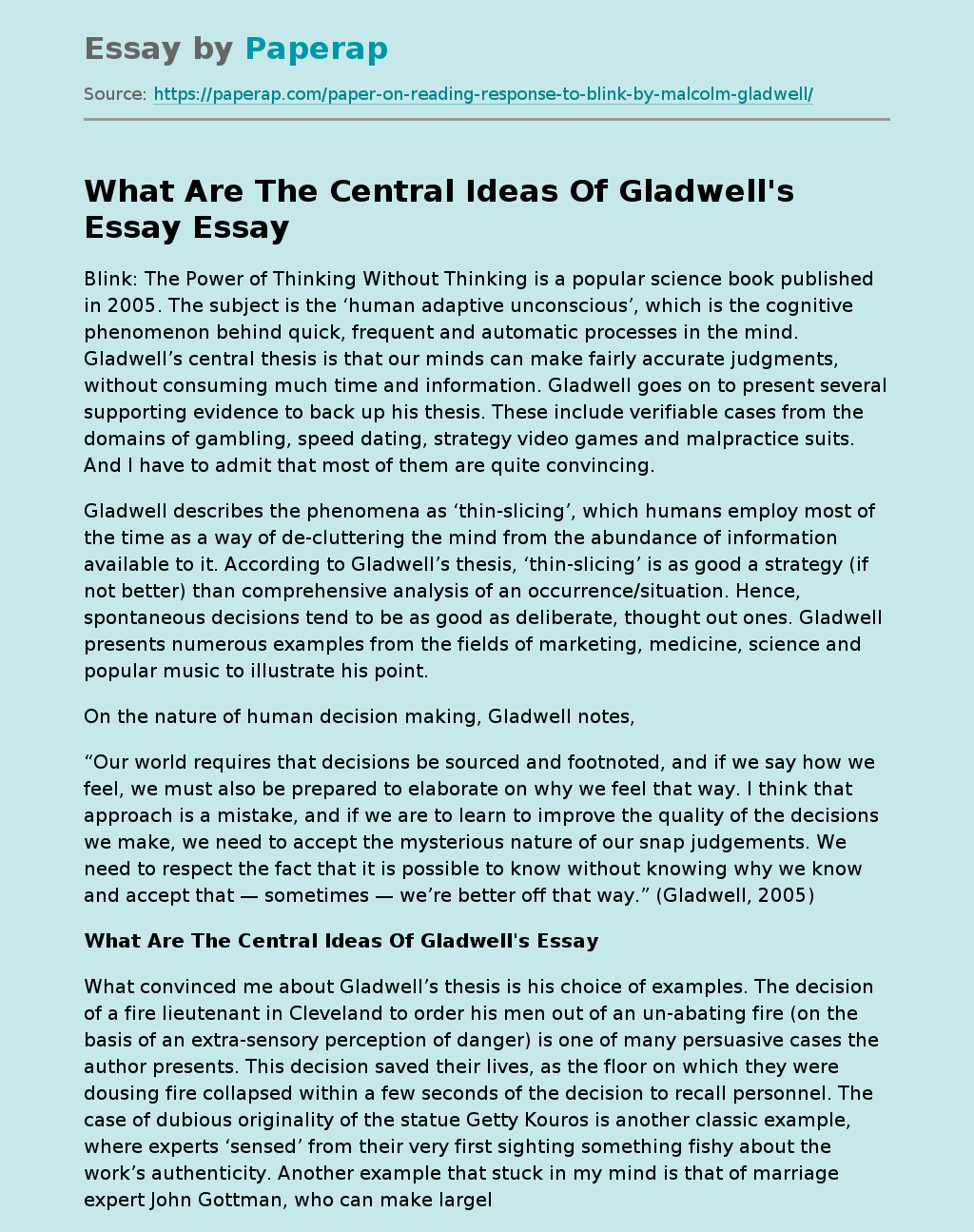What Are The Central Ideas Of Gladwell's Essay
Blink: The Power of Thinking Without Thinking is a popular science book published in 2005. The subject is the ‘human adaptive unconscious’, which is the cognitive phenomenon behind quick, frequent and automatic processes in the mind. Gladwell’s central thesis is that our minds can make fairly accurate judgments, without consuming much time and information. Gladwell goes on to present several supporting evidence to back up his thesis. These include verifiable cases from the domains of gambling, speed dating, strategy video games and malpractice suits.
And I have to admit that most of them are quite convincing.
Gladwell describes the phenomena as ‘thin-slicing’, which humans employ most of the time as a way of de-cluttering the mind from the abundance of information available to it. According to Gladwell’s thesis, ‘thin-slicing’ is as good a strategy (if not better) than comprehensive analysis of an occurrence/situation. Hence, spontaneous decisions tend to be as good as deliberate, thought out ones. Gladwell presents numerous examples from the fields of marketing, medicine, science and popular music to illustrate his point.
On the nature of human decision making, Gladwell notes,
“Our world requires that decisions be sourced and footnoted, and if we say how we feel, we must also be prepared to elaborate on why we feel that way. I think that approach is a mistake, and if we are to learn to improve the quality of the decisions we make, we need to accept the mysterious nature of our snap judgements. We need to respect the fact that it is possible to know without knowing why we know and accept that — sometimes — we’re better off that way.
” (Gladwell, 2005)
What Are The Central Ideas Of Gladwell’s Essay
What convinced me about Gladwell’s thesis is his choice of examples. The decision of a fire lieutenant in Cleveland to order his men out of an un-abating fire (on the basis of an extra-sensory perception of danger) is one of many persuasive cases the author presents. This decision saved their lives, as the floor on which they were dousing fire collapsed within a few seconds of the decision to recall personnel. The case of dubious originality of the statue Getty Kouros is another classic example, where experts ‘sensed’ from their very first sighting something fishy about the work’s authenticity. Another example that stuck in my mind is that of marriage expert John Gottman, who can make largely accurate predictions on the durability of marriages by simply watching the couple speak for an hour.
Hence, my overall impression of the book is one of assent, as supporting evidence for the thesis seemed fairly robust. But there are a few flaws and deficiencies as well. Firstly, Gladwell seems to claim that ‘thin-slicing’ is a fairly robust and dependable way of arriving at spot judgments. But this goes against the grain of conventional wisdom as many key decisions in life have to be deliberately considered and decided. The tendency to ‘thin-slice’ suppresses our critical thinking faculties, which is a more dependable tool in the long run. For example, the author seems to suggest that the subconscious, intuitive and the paranormal should occupy a higher place than rationality and rigorous reasoning:
“There can be as much value in the blink of an eye as in months of rational analysis… research suggests that what we think of as free will is largely an illusion: much of the time, we are simply operating on automatic pilot, and the way we think and act – and how well we think and act on the spur of the moment – are a lot more susceptible to outside influences than we realize.” (Gladwell, 2005)
But the dominance of the adaptive unconscious and the threat of ‘analysis paralysis’ should not dissuade us from eliminating valuable information from the decision making process. In this aspect, I would say that the author’s emphasis on the validity of ‘thin-slicing’ and the power of the unconscious is exaggerated.
Barring the few criticisms pointed to above, the book is a valuable addition to collegiate libraries. This book is relevant to the classroom, for it exposes students to off-beat occurrences and unusual phenomena which do not usually feature in their textbooks. This will widen students’ intellectual horizons and also sharpen their perceptive ability. Ideally, the book could be incorporated into the psychology/sociology curriculum as an ‘elective’ subject, where interested students can take up credits.
Work Cited:
Gladwell, Malcolm, Blink, published by Back Bay Books in 2005, ISBN 0-316-17232-4
What Are The Central Ideas Of Gladwell's Essay. (2019, Dec 05). Retrieved from https://paperap.com/paper-on-reading-response-to-blink-by-malcolm-gladwell/

